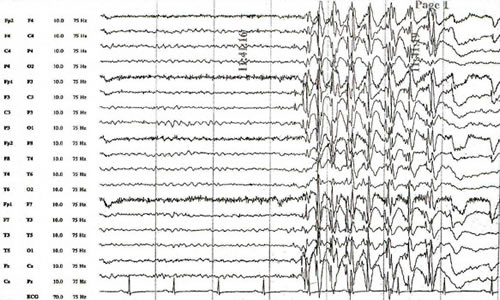For a healthily functioning nervous system, the activities taking place are not synchronized. They work at different speeds or frequencies depending on the work they are carrying out.
When a person is going through a seizure caused by epilepsy, a group of neurons will start firing in synchronization. Not only that, but the activity will be rapid and excitatory. This is why the person will appear to be partially or fully be jerking muscles at the same time.
You can understand the types of seizures and how they affect different parts of the body by watching the video here and educate yourself about epilepsy.
Here is the EEG of a person during an epileptic attack. Looking at the lines on the page, one can easily tell that it is quite excitatory and one can only imagine what the victim’s brain and body are going through during this traumatic time.

There are many videos and testimonies online where patients so generously share their personal stories about what it is like going through a seizure. The fact of the matter is that it is traumatic for both the victim and the loved ones surrounding them.
Sometimes seizures occur with warning. There is a story of a boy who said that he knew he was going to come under attack because for three days he would get headaches and then on the third day he would get an epileptic seizure. He knows what he is going through because he was diagnosed with the neurological disorder since birth. There are those who may have suffered with a head injury or who’s brain has been affected in some way either with a parasite or due to substance or alcohol abuse and may not be aware that they are epileptic and suddenly find themselves controlled by the disorder when they least expect it.
Depending on what type of seizure the person is going through, the experience may be different. The common things that happen before, during and after an episode are as follows:
- Aura – seeing or smelling something
- Sound, no sight. For gran-mall seizures the patient blanks out throughout the entire episode
- The patient will not have any control over bodily function. If not near a secure area, the person could injure themselves because of the flailing of the arms and being unable to sit or find a secure location
- Rapid movement of some or all muscles with spasm like reflexes
- The patient may froth at the mouth, lips would turn blue and eyes would roll back
- Prolonged attack – an epileptic seizure would occur for a few seconds to several minutes
- Post-attack excitement – after the main episode is over, the patient would begin to get excited and would need to be calmed down. At this point the patient will still not be fully coherent or “conscious”.
- The final part is when the victim is aware of their surroundings again. In minor cases they would remember what went on and be a little frightened, but in major cases the person would have no recollection whatsoever of what went on.
- The person may experience weakness in the muscles for days after the episode and in general be slightly disoriented, especially if not “experienced” with epilepsy.
It needs to be understood that someone who goes through all of this is going to have physical and mental pain, not to mention the trauma of having a seizure and not remembering what happened during the attack, waking up after the episode and finding themselves in contorted positions on the floor or in a pool of blood due to an injury suffered during the seizure. There needs to be supportive loved ones who can be around at all times and calm and control the patient when such an attack occurs.
Image Source: pixabay.com
Liked the article on What A Seizure Feels And Looks Like and have your own input? Comment below and don’t forget to share this article!









